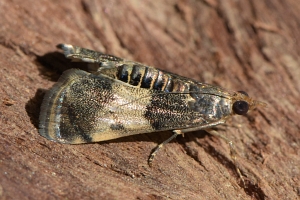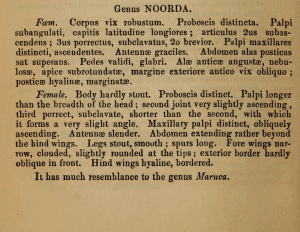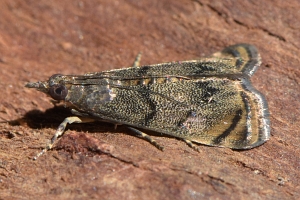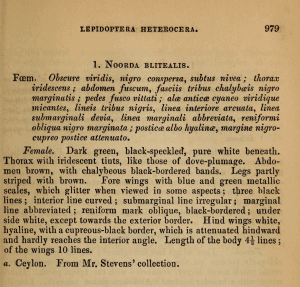

 +19Kontinente:EUASAFOC
+19Kontinente:EUASAFOC1. Lebendfotos
1.1. Falter
2. Diagnose
2.1. Erstbeschreibung
3. Biologie
3.1. Nahrung der Raupe
- [Moringaceae:] Moringa oleifera [= Guilandina moringa] (Meerrettichbaum, Behennussbaum)
- [Moringaceae:] Moringa stenopetala (Afrikanische Moringa)
Die Raupe frisst vor allem Blätter von Moringa oleifera, sie bohrt sich aber auch in heranreifende Früchte ein, die sie vor der Verpuppung über ein kleines Loch wieder verlässt. Der mitunter komplette Blattfraß ist der Hauptgrund, warum sie als "Schädling" dieses Baumes gilt. Die Verbreitung der Arten der Gattung Noorda deckt sich im wesentlichen mit der Verbreitung der Pflanzengattung Moringa; die artenarme Familie der Moringaceae ist mit den Brassicaceae und Capparidaceae verwandt und enthält ebenfalls Senfölglykoside als wichtige Inhaltsstoffe.
Bibata et al. (2023: 92) trugen zusammen: "Among the major pests of moringa is the moringa leaf caterpillar, Noorda blitealis Walker 1859 (Ratnadass et al., 2011; Halder et al., 2014; Math et al., 2014; Litsinger, 2014; Joshi et al., 2016; Sharjana and Mikunthan, 2018; Kabré, 2021). It can cause 100% defoliation and thus poses a threat to moringa production (Brunda et al. 2015)." Und weiter zum Schaden: "The larvae of N. blitealis, as soon as it emerges from the egg, starts to attack the parenchyma of tender leaves by biting and absorbing the sap, leaving only the transparent epidermis and the veins bare. This causes drying, discoloration and necrosis. They feed almost exclusively on the leaves. Attack occurs throughout the year, although it is more severe in the dry season than in the winter (Walser, 2015). Early attacks can cause up to 100% leaf loss (Rachana et al., 2020). This defoliation gives the tree a skeletal appearance. The larvae devour any new leaves that form, and in the complete absence of leaves, the caterpillar can attack the apical buds and stems of young plants in which it digs galleries causing the feet to dry out. When the tree is pruned, the larvae feed on the bark of the tree. Under these conditions, they feed on the corky contents of the bark (Satti et al., 2013). During periods of severe damage, entire branches of the moringa tree become defoliated and cause vegetable shortages for rural and urban communities in semi-arid areas (Anjulo, 2009)." S. 94 ist zu erfahren: "In West Africa, the two most widely grown Moringa oleifera varieties (PKM1, PKM2) and the single M. stenopetala variety are highly susceptible to the pest (Haougui, pers. obs.)."
(Autor: Erwin Rennwald)
4. Weitere Informationen
4.1. Synonyme
- Scopula subjectalis Walker, [1866] [Synonym nach funet.fi]
- Argyria holocrossa Meyrick, 1902 [Synonym nach funet.fi]
- Noorda moringae Tams, 1938 [Synonym nach Fazekas & Edmunds (2025)]
4.2. Taxonomie und Faunistik
Noorda blitealis und damit die Typusart der Gattung Noorda wurde von Walker (1859: 978-979) nach einem weiblichen Sammlungsexemplar von Ceylon (jetzt Sri Lanka) beschrieben. Dass das die ursprüngliche Heimat des Falters war, ist damit nicht gesagt - es spricht einiges dafür, dass er erst mit dem Anbau seiner wichtigsten (oder gar einzigen (?)) Raupennahrungspflanze, dem aus Nordwestindien stammenden Meerrrettichbaum (Moringa oleifera) hierher kam. Der Falter ist auch heute noch auf dem Indischen Subkontinent mit dem Anbau dieser Pflanze verbreitet und gilt als einer ihrer wichtigsten "Schädlinge" unter den Insekten (z.B. Thumar et al. (2017). Bibata et al. (2023: 92-93) nennen ihren Artikel: "The Moringa Leaf Caterpillar (Noorda blitealis Walker, 1859), a Major Pest of Moringa (Moringa oleifera Lam.) Worldwide." Sie listen zur Verbreitung: "Noorda blitealis is a lepidopteran whose larva or caterpillar is the damaging stage on the moringa tree. Due to the significant expansion of moringa cultivation in the world, the pest is continuously expanding its area of distribution in recent years. It is reported as a pest of moringa in Asia where it originates and in several other tropical regions (Thumar et al., 2017). Noorda blitealis is also found in Australia and Africa. It occurs in Niger (Ratnadass et al., 2011; Chegou and Garba, 2019; Republic of Niger, 2022), Sudan, Burkina Faso, and Nigeria (Joshi et al, 2016). Taye et al., (2013) noted its presence in Ethiopia."
Fazekas & Edmunds (2025) melden den Erstnachweis der Art für Kreta und damit für Europa: "The second author operated a Robinson 125w mv moth trap in the garden of his house on the island of Crete (Villa Xylia, Agios Georgios). On May 2, 2024, a specimen of Noorda blitealis was caught in the trap. Specimens of unusual species from this trap are routinely shown to Colin W Plant, in England; he agreed with the identification." Sie verglichen: "Based on our knowledge of the literature, this is the first recorded occurrence of this species in Europe. It has a disjunct distribution world-wide. It is present throughout much of the Indian continent where it is known as a pest of Moringa (drumstick tree, horseradish tree, or malunggay). It also affects south-eastern Arabia, Israel, southern Africa, north-western Africa and has outlying populations in south-east Asia and northern Australia."
Das Exemplar von Kreta wurde einem Barcoding unterzogen, mit recht interessantem Ergebnis: "This sequence places the sample in BIN BOLD: ABV2008, indicating that it is closely related to Israeli specimens rather than to typical blitealis. This relationship is expressed in the BOLD joining tree in Fig. 5. It seems highly probable on the basis of these data, that the Cretan specimens were of Israeli origin. The DNA results also strongly indicate that this population represents a new and separate species, though describing it on the basis of a single, probable migrant specimen is unwise. A broader review of the genus is called for."
Aus dem gezeigten Barcoding neighbour tree wird klar: Die Tiere aus Indien, Pakistan und aus den Vereinigten Arabischen Emiraten gehören zur gleichen Art, wahrscheinlich auch zur gleichen Unterart, und auch das untersuchte Exemplar von West-Australien stammt wohl ursprünglich aus diesem Raum, unterscheidet sich im Barcode jedenfalls nicht. Das Tier vom Oman könnte auch noch dazu passen. Die Tiere aus Israel und das Exemplar von Kreta gehören zusammen - unterscheiden sich im Barcode aber so deutlich, dass zu überprüfen ist, ob es sich nicht um eine eigene Art handelt. Die untersuchten Exemplare der Seychellen kommen dem noch am nächsten, könnten aber eine weitere getrennte Art sein. Noch viel stärker von alledem weichen die untersuchten Tiere aus Namibia ab - hier ist zwingend davon auszugehen, dass die Zuordnung zu Noorda blitealis falsch und die Art erst noch zu beschreiben ist. Für die weiteren Nachweise aus Afrika liegen keine Barcoding-Ergebnisse vor - die Zuordnung zu einem der Cluster ist daher nicht möglich.
(Autor: Erwin Rennwald)
4.3. Literatur
- Bibata, A.O., Haougui, A., Basso, A., Ali, M. & P. Delmas (2023): The Moringa Leaf Caterpillar (Noorda blitealis Walker, 1859), a Major Pest of Moringa (Moringa oleifera Lam.) Worldwide. — Scholars Academic Journal of Biosciences, 11 (3): 92–97. [zum open-access-Artikel auf saspublishers.com]
- Fazekas, I. & H. Edmunds (2025): A New Moth species in Europe: Noorda blitealis Walker, 1859 on the Island of Crete (Lepidoptera, Crambidae). — Lepidopterologica Hungarica, 21:9-16. DOI: 10.5281/zenodo.14803279. [zum PDF-Download auf researchgate.net]
- Thumar, R.K., Borad, M.G., Padaliya, S.R. & P.K. Borad (2017): First Report of Leaf Eating Caterpillar Noorda blitealis Walker (Lepidoptera: Crambidae) Infesting Drumstick, Moringa oleifera Lam. from Middle Gujarat. — Trends in Biosciences, 10 (2): 4324–4325. [zum PDF-Download auf researchgate.net]
- Erstbeschreibung: Walker, F. (1859): List of the Specimens of Lepidopterous Insects in the Collection of the British Museum 19: 799-1036. London.























